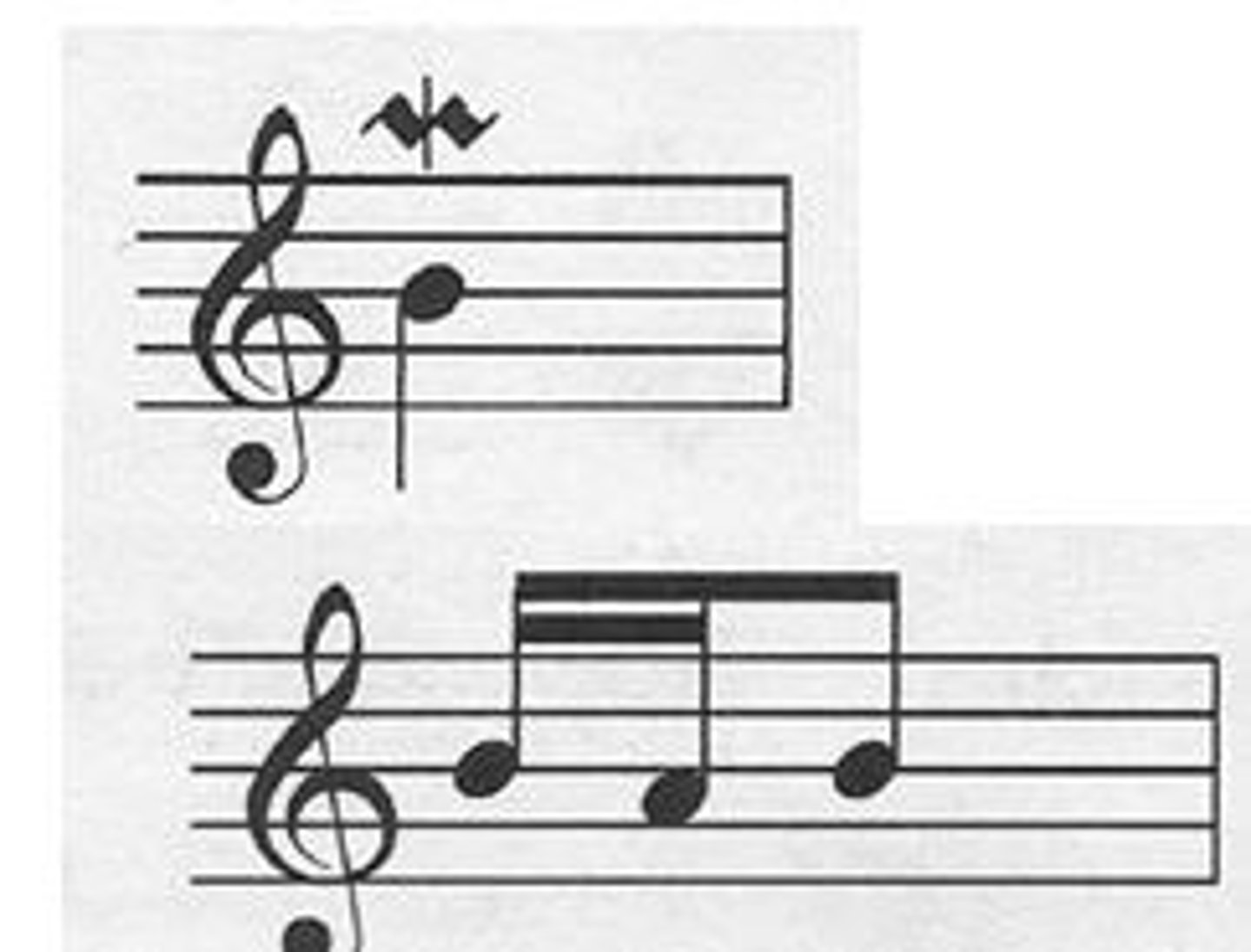music: vocab, eras etc.
1/53
There's no tags or description
Looks like no tags are added yet.
Name | Mastery | Learn | Test | Matching | Spaced |
|---|
No study sessions yet.
54 Terms
homophony
texture where all parts move together at the same rate, with highest part being most prominent
chordal homophony
stricter type of homophony where different parts move together, forming a sequence of chords
melody dominated homophony
also called melody and accompaniment - looser form of homophony where there is a clear focus on the main melody, with other parts playing accompanimental role
monophony/monody
texture where there is a single line of music without accompanying harmony
unison
when two or more musical parts play the same music as each other
octave unison
unison where both parts play the same notes, but in different octaves
antiphony
alternating responses between 2 parts
polyphony/counterpoint
texture where different and independent melodic lines are heard at the same time
types of cadence
perfect
imperfect- I-V
interrupted - V-VI
plagal - IV-I (assoc. with church music)
motif
musical idea - a short melodic or rhythmic phrase that is repeated and subjected to change and transformation in a passage of music
ostinato
a distinctive motif or rhythmic phrase that is repeated and subjected to change and transformation in a passage of music - ostinato is longer than motif
countermelody
a secondary melody heard at the same time as the main tune, which complements it
basso continuo
a bassline played by a single-line instrument (cello and bass) accompanied by a chordal instrument improvising a harmony part - key in BAROQUE
diatonic
music that uses the pitches of home key
chromatic
antonym of diatonic - music uses pitches from outside home key (often resulting in dissonance)
modal
scale/pitch collection that occurred before tonal music emerged - does not have cadence/modulate in the same way as tonal music as leading note is often flattened
atonal
music that doesn’t follow the tonal or modal system, without an identifiable home pitch - emerged in the early 20th century - music often chromatic and dissonant
simple time
music with 4 at bottom of time signature
compound time
music with 8 at bottom of time signature
swung quavers/semis
jazz technique of playing quavers in a long-short pattern
tessitura
main pitch range of an instrument/vocal part
melisma
singing of more than one note to a single syllable of text
syllabic word setting
a way of setting words so that each syllable has a single note
secondary dominant
a chord which functions as the dominant of a chord other than the tonic
forms
binary form - two part AB structure
ternary form - three part structure, usually ABA
sonata form
rondo form - based on repetition of a theme, separated by intervening episodes, often ABACA
sonata form
exposition - 1st and second subject
development - musical ideas explored, range of keys visited
recapitulation - concluding section - original first and second subject theme heard, now both in home key
(coda) - concluding part of musical composition
CLASSICAL
music moves from home key to second key then back again
symphony
large-scale work for orchestra, usually 4 movements, common from classical period
sonata
multi-mvmt work for single player or single player + piano accomp.
concerto
piece for solo performer accompanied by orchestra
song without words
short Romantic piece for solo piano with song-like qualities - created by Felix Mendelssohn + Fanny Hensel in 19th cent.
imitation
where one line of music copies the melody of another, often at different pitch and usually with entry of second part overlapping completion of first
canon
repeating a melody but starting after time delay
hemiola
rhythmic phrasing of two bars of triple time music as if they were three bars of duple time
BAROQUE
a cappella
choral music performed without instrumental accomp.
mordent

turn

anacrusis
upbeat - an unstressed pickup or lead-in note or group of notes that goes before the first accented note of a phrase
consonance
when notes are sounded together and produce a sound associated with sweetness, pleasantness and lack of tonal tension
dissonance
absence of consonance and associated with harshness and unpleasantness - spectrum from mildly to extremely dissonant
pedal point/note
sustained/repeated bass note over which the harmony changes
circle of fifths
harmonic progression where bass moves progressively by interval of a fifth
sections of a pop song
verse
pre-chorus
chorus
middle-eight
intro
outro
sequence
melodic phrase that is repeated, getting progressively higher (ascending sequence) or lower (descending sequence)
conjunct
movement by step - when melody moves up/down to next nearest note within scale
disjunct
movement by skip/leap, when melody moves up or down by larger interval than a step
medieval
anything up to and incl. 1400
earliest examples - 900-1000
composer: hildegard
renaissance
1400s-1600
choral - SATB - church music
lots of instrumental, not much written down
polyphonic/contrapuntal
composer: palestrina
baroque
1600-1750
contrapuntal
harpsichord, basso continuo
composers: js bach, handel, purcell
classical
1750-1830
often diatonic, regular and balanced phrases
strings, esp violins, flutes, trumpets, timps but not much percussion, singing, piano
composers: mozart, beethoven (mix of classical and romantic),
romantic
1830-1900
dissonance/chromaticism
harmonies get richer, melodies fuller, more free
listen out for dissonant chords and unusual instruments, e.g. percussion
composers: schumann, chopin (smaller piano pieces), rachmaninoff (big orchestral pieces), wagner (opera)
20th century (modern)
1900 onwards
minimalism, atonality (from 1909)
composers (mostly german): schoenberg (atonal), philip glass (minimalism)
melodic devices
sequence
ornamentation
passing notes
suspension
harmonic (chords) devices
suspension
pedal
ground bass
cadences
rhythmic devices
syncopation
swung notes
hemiola (baroque)